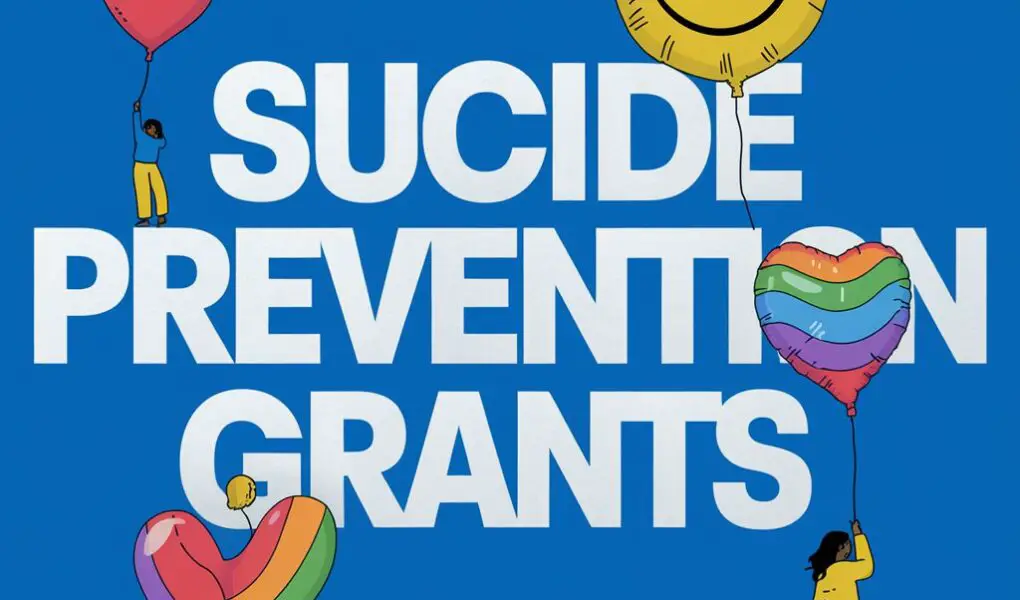Suicide Prevention Funding is critical to providing the necessary resources and support for programs aimed at saving lives and addressing the mental health crises that lead to suicide.
In the United States, suicide rates have been steadily rising, and this alarming trend calls for urgent action. With the right funding, communities, organizations, and healthcare systems can implement effective prevention programs that provide education, resources, and support to those in need.
Understanding where to find grants, how to apply, and how to manage these funds effectively can make all the difference in creating sustainable programs that save lives.
The Growing Need for Suicide Prevention Programs
Suicide is a major public health issue, and its effects are far-reaching. According to the Centers for Disease Control and Prevention (CDC), nearly 46,000 Americans die by suicide every year, with the highest rates seen in young adults and middle-aged men. This shocking statistic highlights the urgency for targeted suicide prevention efforts, which can range from mental health screenings, counseling services, and crisis intervention programs to public awareness campaigns aimed at reducing stigma.
Why the Urgency?
The rise in suicide rates can be attributed to various factors, including increased mental health issues, economic stressors, social isolation, and the pervasive impact of the COVID-19 pandemic. The pandemic not only exacerbated existing mental health challenges but also introduced new stressors such as unemployment, grief, and disrupted social networks. Addressing these multifaceted issues requires a coordinated effort supported by adequate funding.
Impact on Communities
The impact of suicide extends beyond the individuals directly affected. Families, friends, workplaces, and entire communities bear the emotional and economic burdens. Funding for suicide prevention programs can help mitigate these impacts by providing essential services, fostering community resilience, and promoting overall mental well-being.
Sources of Suicide Prevention Funding
Funding for suicide prevention can come from a variety of sources, each with its own set of opportunities and requirements. Understanding these sources is the first step in securing the necessary resources for your program.
1. Federal Grants
Federal Grants are a significant source of funding for suicide prevention initiatives. Agencies like the Substance Abuse and Mental Health Services Administration (SAMHSA) and the Centers for Disease Control and Prevention (CDC) offer numerous grant programs dedicated to mental health and suicide prevention.
- SAMHSA’s Grants: SAMHSA provides grants such as the Crisis Counseling Assistance and Training Program (CCP) and the State Suicide Prevention Program (SSPP). These grants fund crisis intervention services, training programs, and research initiatives.
- CDC’s Suicide Prevention Grants: The CDC offers grants through its National Violent Death Reporting System (NVDRS) and Suicide Prevention Research Grants. These grants support data collection, research, and the implementation of evidence-based prevention strategies.
How to Access Federal Grants:
- Grants.gov: This is the primary portal for finding and applying for federal grants. It provides a comprehensive database of available grants, application deadlines, and detailed guidelines.
- SAMHSA and CDC Websites: Regularly check these agencies’ websites for updates on grant opportunities and application requirements.
2. State and Local Grants
State and local governments often have their own funding programs to support suicide prevention efforts. These grants can be tailored to address specific regional needs and may offer more flexibility than federal grants.
- State Health Departments: Many states have dedicated mental health departments that offer grants for suicide prevention. For example, California’s Suicide Prevention Program provides funding to counties to implement localized prevention strategies.
- Local Government Initiatives: Cities and municipalities may offer grants to community organizations and local nonprofits. These grants can support initiatives like school-based programs, community outreach, and local helplines.
Finding State and Local Grants:
- State Government Websites: Visit your state’s health department or official government website to find information on available grants.
- Local Mental Health Organizations: Partnering with local mental health organizations can provide insights into additional funding opportunities and collaborative projects.
3. Private Foundations and Nonprofits
Private foundations and nonprofit organizations play a crucial role in funding suicide prevention programs. These organizations often focus on specific aspects of mental health and may offer grants for research, outreach, awareness campaigns, and community-based prevention efforts.
Key Organizations:
- The American Foundation for Suicide Prevention (AFSP): AFSP provides grants for research, advocacy, and community programs aimed at reducing suicide rates.
- The National Alliance on Mental Illness (NAMI): NAMI offers funding for programs that support individuals with mental illness and their families, including suicide prevention initiatives.
- The Jed Foundation (JED): JED focuses on youth mental health and offers grants to programs that support high school and college students.
- The Trevor Project: This organization provides grants for programs specifically targeting LGBTQ+ youth, who are at higher risk for suicide.
Securing Private Grants:
- Research Foundation Guidelines: Each foundation has its own set of guidelines and priorities. Carefully review these before applying to ensure alignment with your program’s goals.
- Networking: Building relationships with foundation representatives and attending relevant conferences can increase your chances of securing funding.
4. Corporate Social Responsibility (CSR) Funding
Many corporations have Corporate Social Responsibility (CSR) programs that fund mental health and suicide prevention initiatives. Companies in sectors such as healthcare, technology, and finance often invest in community well-being as part of their CSR efforts.
Examples of Corporate Funders:
- Google.org: Google’s philanthropic arm supports innovative mental health solutions, including suicide prevention technologies and research.
- Facebook: Facebook has funded mental health awareness campaigns and crisis intervention tools, leveraging its platform to reach at-risk individuals.
How to Approach Corporate Funders:
- Align with Corporate Values: Ensure your program aligns with the company’s CSR goals and values.
- Proposal Customization: Tailor your grant proposal to highlight how your program complements the company’s existing initiatives and how it can provide mutual benefits.
Types of Suicide Prevention Programs Funded
When applying for suicide prevention grants, it’s essential to align your proposal with the types of programs that funders typically support. Below are the most common categories of funded programs, along with examples and best practices.
1. Education and Awareness Campaigns
Purpose: These campaigns aim to reduce the stigma surrounding mental health issues and promote awareness about suicide prevention resources.
Examples:
- Media Campaigns: Creating television, radio, and social media advertisements that highlight the importance of seeking help.
- Educational Workshops: Hosting workshops in schools, workplaces, and community centers to educate individuals about mental health and suicide prevention.
Best Practices:
- Target Audience: Clearly define who your campaign is aimed at (e.g., teenagers, veterans, general population).
- Message Clarity: Ensure your messaging is clear, compassionate, and free of stigmatizing language.
- Evaluation Metrics: Include methods to assess the reach and impact of your campaign, such as surveys or engagement metrics.
2. Crisis Intervention Services
Purpose: These services provide immediate support to individuals experiencing a mental health crisis, potentially preventing suicide.
Examples:
- Suicide Hotlines: Establishing or maintaining a 24/7 helpline staffed by trained counselors.
- Mobile Crisis Units: Deploying teams to provide on-the-spot assistance to individuals in crisis.
Best Practices:
- Accessibility: Ensure services are easily accessible, including multilingual support and availability in multiple formats (phone, text, online chat).
- Training: Regularly train staff in crisis intervention techniques and cultural competency.
- Collaboration: Partner with local hospitals, law enforcement, and mental health professionals to provide comprehensive support.
3. Training Programs
Purpose: Training programs equip community members, healthcare professionals, and educators with the skills to identify and respond to signs of suicidal ideation.
Examples:
- Gatekeeper Training: Teaching individuals to recognize warning signs of suicide and how to intervene effectively.
- Mental Health First Aid: Providing foundational mental health support skills to non-professionals.
Best Practices:
- Comprehensive Curriculum: Develop a thorough training program that covers identification, intervention, and referral processes.
- Certification: Offer certification upon completion to encourage participation and provide proof of training.
- Ongoing Support: Provide resources and follow-up support for trained individuals to ensure they can apply their skills effectively.
4. Research and Data Collection
Purpose: Research initiatives aim to understand the underlying causes of suicide and evaluate the effectiveness of prevention strategies.
Examples:
- Epidemiological Studies: Investigating trends and risk factors associated with suicide.
- Intervention Research: Testing the effectiveness of new prevention methods or treatment protocols.
Best Practices:
- Collaborative Research: Partner with academic institutions and research organizations to enhance study design and credibility.
- Ethical Considerations: Ensure all research is conducted ethically, with appropriate safeguards for participants.
- Dissemination: Share findings widely through publications, conferences, and community presentations to inform best practices.
5. Support for At-Risk Populations
Purpose: Programs targeting at-risk groups provide specialized support tailored to the unique challenges faced by these populations.
Examples:
- Veterans: Providing mental health services and suicide prevention resources specifically for military veterans.
- Individuals with Chronic Illnesses: Supporting those with long-term health conditions that may contribute to mental health struggles.
Best Practices:
- Cultural Competency: Ensure programs are culturally sensitive and address the specific needs of the target population.
- Holistic Support: Incorporate various forms of support, including mental health services, social support, and practical assistance.
- Community Involvement: Engage members of the at-risk population in program design and implementation to ensure relevance and effectiveness.
Steps to Apply for Suicide Prevention Grants
Securing funding for suicide prevention programs involves a systematic approach. Here’s a detailed step-by-step guide to help you navigate the grant application process successfully.
1. Identify the Right Funding Opportunity
Research Extensively:
- Grants Databases: Utilize platforms like Grants.gov, Foundation Directory Online, and SAMHSA’s Grant Programs to find relevant opportunities.
- Funding Alerts: Subscribe to newsletters or alerts from funding agencies to stay informed about new grant announcements.
Assess Eligibility:
- Requirements: Carefully review eligibility criteria, including organizational type, program focus, and geographic location.
- Fit: Ensure that your program’s goals align with the funder’s priorities and objectives.
2. Develop a Clear Proposal
Proposal Components:
- Executive Summary: Provide a concise overview of your program, its goals, and the funding requested.
- Needs Statement: Present data and evidence that demonstrate the need for your program in your target area.
- Objectives: Clearly define what you aim to achieve with specific, measurable outcomes.
- Methods: Describe the strategies and activities you will implement to reach your objectives.
- Evaluation Plan: Outline how you will assess the effectiveness of your program, including metrics and data collection methods.
Writing Tips:
- Clarity and Brevity: Use clear, straightforward language. Avoid jargon and overly technical terms.
- Compelling Narrative: Tell a story that highlights the urgency and importance of your program. Personal anecdotes or case studies can be powerful.
- Data-Driven: Incorporate relevant statistics and research to support your proposal and demonstrate the program’s potential impact.
3. Budgeting
Detailed Breakdown:
- Line Items: Provide a detailed breakdown of all costs, including personnel, equipment, supplies, travel, and indirect costs.
- Justification: Explain the necessity of each budget item and how it contributes to the program’s success.
Best Practices:
- Realistic Estimates: Ensure all budget estimates are realistic and based on thorough research.
- Flexibility: Allow for some flexibility to accommodate unexpected expenses without compromising program integrity.
4. Collaboration
Building Partnerships:
- Local Organizations: Partner with local mental health organizations, schools, healthcare providers, and community groups to strengthen your proposal.
- Shared Resources: Leverage each partner’s strengths and resources to enhance program delivery and effectiveness.
Benefits of Collaboration:
- Increased Credibility: Demonstrates broad support and reduces the perceived risk for funders.
- Resource Sharing: Access to additional expertise, networks, and resources can enhance program quality.
5. Follow the Application Guidelines
Attention to Detail:
- Formatting Requirements: Adhere to specified formatting guidelines, including font size, margins, and document structure.
- Required Documents: Ensure all necessary documents are included, such as letters of support, IRS determination letters, and organizational budgets.
Deadlines:
- Timely Submission: Submit your application well before the deadline to avoid last-minute issues.
- Confirmation: Confirm receipt of your application and keep records of all submissions.
6. Prepare for Evaluation
Evaluation Components:
- Process Evaluation: Assess how well the program was implemented according to the plan.
- Outcome Evaluation: Measure the program’s impact on reducing suicide rates and improving mental health.
Data Collection Methods:
- Surveys and Questionnaires: Collect feedback from program participants and stakeholders.
- Statistical Analysis: Use quantitative methods to analyze changes in suicide-related metrics.
Reporting:
- Regular Updates: Provide funders with regular progress reports and final evaluation results.
- Transparency: Be honest about challenges and how you addressed them, demonstrating accountability and learning.
How to Improve Your Chances of Securing Suicide Prevention Funding
Securing grants can be competitive, but by following these strategies, you can enhance your likelihood of success.
Be Specific
Clear Goals:
- Define precise objectives and outcomes that your program aims to achieve.
- Avoid vague statements; instead, use SMART goals (Specific, Measurable, Achievable, Relevant, Time-bound).
Detailed Plans:
- Provide a step-by-step plan of action, detailing each phase of the program.
- Include timelines and milestones to show funders that your program is well-organized and feasible.
Use Data
Support Your Case:
- Utilize local and national statistics to highlight the severity of the suicide issue in your area.
- Reference reputable sources like the CDC, SAMHSA, and peer-reviewed journals to back your claims.
Data Integration:
- Integrate data seamlessly into your proposal to reinforce your needs statement and objectives.
- Use charts, graphs, and tables to present data clearly and effectively.
Highlight Sustainability
Long-Term Planning:
- Demonstrate how your program will continue to operate and have an impact after the initial funding period.
- Include plans for future funding, community support, and ongoing program evaluation.
Capacity Building:
- Invest in training and infrastructure that will allow your organization to maintain the program independently.
- Show that you have a strategy for scaling and adapting the program as needed.
Demonstrate Community Support
Letters of Support:
- Include letters from community leaders, partner organizations, and stakeholders endorsing your program.
- Highlight any community involvement in the program’s design and implementation.
Engagement Strategies:
- Show how you plan to engage the community and ensure their active participation in the program.
- Include plans for outreach, feedback mechanisms, and community advisory boards.
Use Impact Stories
Personal Testimonials:
- Share stories from individuals who have benefited from your program or similar initiatives.
- Use these narratives to illustrate the real-life impact of your work.
Case Studies:
- Present case studies that demonstrate the effectiveness of your program’s approach.
- Highlight specific instances where your intervention made a significant difference.
Additional Resources for Suicide Prevention Funding
Accessing the right resources can significantly enhance your ability to secure funding and implement effective suicide prevention programs. Here are some valuable resources to consider:
- The National Suicide Prevention Lifeline (Lifeline): Offers resources, training, and data on suicide prevention.
- SAMHSA’s Suicide Prevention Resource Center (SAMHSA): Provides grant opportunities, toolkits, and support for mental health programs.
- The American Foundation for Suicide Prevention (AFSP): Offers grants, advocacy resources, and community programs focused on suicide prevention.
- Grants.gov (Grants.gov): The main portal for finding and applying for federal grants, including those related to suicide prevention.
- Foundation Directory Online (Foundation Directory): A comprehensive database of private foundation grants and grantmakers.
- GrantSpace by Candid (GrantSpace): Provides training, resources, and support for nonprofits seeking grants.
- National Institute of Mental Health (NIMH) (NIMH): Offers funding for mental health research, including studies on suicide prevention.
Success Stories: Programs That Made a Difference
Highlighting successful suicide prevention programs can provide inspiration and practical insights into effective strategies.
The Garrett Lee Smith Memorial Act
Overview:
- Established in 2004, the Garrett Lee Smith Memorial Act provides federal funding to support suicide prevention programs targeting youth.
- Named after Garrett Lee Smith, a young man whose death by suicide galvanized nationwide efforts to address youth mental health.
Impact:
- Funded over 400 programs across the United States, reaching millions of young people.
- Supported initiatives like mental health education, suicide prevention training, and the development of youth-friendly mental health services.
Key Takeaways:
- Targeted Funding: Focusing on a specific population (youth) can create meaningful and measurable impacts.
- Comprehensive Approach: Combining education, training, and service provision addresses multiple facets of the issue.
The Veterans Crisis Line
Overview:
- Launched by the U.S. Department of Veterans Affairs (VA), the Veterans Crisis Line provides confidential support to veterans in crisis.
- Offers 24/7 access via phone, text, and online chat, staffed by trained responders.
Impact:
- Handles over 1 million contacts annually, providing immediate support and connecting veterans to local resources.
- Has been instrumental in reducing suicide rates among veterans through timely intervention and ongoing support.
Key Takeaways:
- Accessibility: Multiple contact methods ensure that veterans can reach out in the way that feels most comfortable to them.
- Specialization: Tailoring services to the unique experiences and needs of veterans enhances effectiveness.
The Trevor Project’s Lifeline
Overview:
- The Trevor Project focuses on suicide prevention among LGBTQ+ youth.
- Operates the TrevorLifeline, a 24/7 crisis intervention service for LGBTQ+ individuals.
Impact:
- Provides over 200,000 contacts annually, including calls, texts, and online chats.
- Offers additional resources like counseling, educational materials, and community support.
Key Takeaways:
- Inclusivity: Creating safe spaces for marginalized groups can significantly improve mental health outcomes.
- Holistic Support: Combining crisis intervention with ongoing support services fosters long-term well-being.
Overcoming Common Challenges in Securing Suicide Prevention Funding
While there are numerous funding opportunities available, organizations often face challenges in securing grants. Here’s how to navigate and overcome these obstacles.
Competition for Grants
Challenge:
- High competition for limited grant funds can make it difficult to secure funding.
Solutions:
- Unique Value Proposition: Clearly articulate what sets your program apart and why it’s a worthy investment.
- Strong Evidence Base: Demonstrate the effectiveness of your program through data and research.
- Build Relationships: Establish connections with funders before applying. Attend workshops, seminars, and networking events to build rapport.
Limited Capacity
Challenge:
- Smaller organizations may lack the capacity to develop comprehensive grant proposals.
Solutions:
- Training and Support: Invest in grant writing training for your team or seek assistance from experienced grant writers.
- Collaborations: Partner with other organizations to share the workload and combine resources for grant applications.
- Simplified Proposals: Focus on creating clear and concise proposals that effectively communicate your program’s value without unnecessary complexity.
Meeting Specific Funder Requirements
Challenge:
- Funders often have strict guidelines and requirements that can be difficult to meet.
Solutions:
- Thorough Review: Carefully read and understand all guidelines before starting your application.
- Tailored Proposals: Customize each proposal to align with the specific requirements and priorities of the funder.
- Professional Editing: Have your proposal reviewed by colleagues or professional editors to ensure compliance and clarity.
Demonstrating Impact
Challenge:
- Funders want to see tangible results, which can be challenging for new or small programs.
Solutions:
- Clear Metrics: Define specific, measurable outcomes that your program aims to achieve.
- Pilot Programs: Implement a pilot phase to demonstrate effectiveness before seeking larger grants.
- Data Collection: Establish robust data collection and analysis methods to track and report on your program’s impact.
Leveraging Technology in Suicide Prevention Funding
Technology plays a vital role in both preventing suicide and managing funding processes. Here’s how you can leverage technology to enhance your suicide prevention efforts and streamline your funding applications.
Digital Outreach and Awareness
Online Campaigns:
- Utilize social media platforms like Facebook, Instagram, and Twitter to run awareness campaigns that reach a broad audience.
- Create engaging content such as videos, infographics, and blog posts to educate the public about suicide prevention.
Webinars and Online Workshops:
- Host virtual training sessions and workshops to educate community members, educators, and healthcare professionals on suicide prevention techniques.
- Use platforms like Zoom or Microsoft Teams to facilitate interactive and accessible training sessions.
Data Management and Reporting
Grant Management Software:
- Implement software solutions like GrantHub, Fluxx, or Foundant to manage grant applications, track deadlines, and organize documentation.
- These tools can help streamline the application process and ensure that all requirements are met efficiently.
Data Analytics:
- Use data analytics tools to monitor and evaluate the effectiveness of your suicide prevention programs.
- Tools like Tableau or Google Analytics can help visualize data trends and present findings in a compelling manner for funders.
Telehealth and Remote Support
Crisis Intervention:
- Offer telehealth services to provide remote counseling and support to individuals in crisis.
- Platforms like Talkspace or BetterHelp can facilitate secure and confidential communication between counselors and clients.
Resource Accessibility:
- Develop a user-friendly website or mobile app that provides access to mental health resources, crisis hotline information, and self-help tools.
- Ensure that these digital platforms are accessible to all, including those with disabilities.
Building a Strong Grant Proposal: Detailed Tips
Creating a compelling grant proposal is essential to securing funding. Here are detailed tips to help you craft a strong proposal that stands out.
Crafting a Compelling Executive Summary
Overview:
- Summarize your program’s mission, objectives, and the amount of funding requested.
- Provide a snapshot that captures the essence of your proposal and entices the reader to explore further.
Key Elements:
- Problem Statement: Briefly describe the issue your program addresses.
- Solution: Outline how your program will tackle the problem.
- Impact: Highlight the expected outcomes and benefits of your program.
Developing a Strong Needs Statement
Importance:
- The needs statement justifies the necessity of your program and convinces funders of its importance.
Components:
- Data and Statistics: Use relevant and recent data to illustrate the severity and scope of the suicide issue in your target area.
- Contextual Information: Provide background information that contextualizes the problem, including social, economic, and cultural factors.
- Personal Stories: Incorporate testimonials or stories that humanize the data and highlight real-life impacts.
Outlining Clear Objectives and Goals
SMART Goals:
- Specific: Clearly define what you aim to achieve.
- Measurable: Ensure that your goals can be quantified or evaluated.
- Achievable: Set realistic and attainable objectives.
- Relevant: Align your goals with the funder’s priorities and your program’s mission.
- Time-bound: Establish a clear timeline for achieving your objectives.
Example:
- Objective: Increase the number of trained gatekeepers in high schools by 50% within one year to better identify and support at-risk students.
Detailing Methods and Strategies
Comprehensive Plan:
- Provide a step-by-step description of the activities and strategies you will implement to achieve your objectives.
- Include timelines, responsible parties, and specific tasks for each phase of the program.
Innovative Approaches:
- Highlight any innovative methods or technologies you will use to enhance program effectiveness.
- Demonstrate how these approaches differentiate your program from others and add value.
Creating a Realistic and Detailed Budget
Budget Categories:
- Personnel: Salaries, benefits, and training costs for staff.
- Program Costs: Supplies, equipment, and materials needed for program activities.
- Administrative Costs: Overhead expenses such as rent, utilities, and office supplies.
- Evaluation Costs: Expenses related to monitoring and evaluating program outcomes.
Justification:
- Provide a clear explanation for each budget item, demonstrating how it contributes to the program’s success.
- Ensure that all costs are reasonable, necessary, and directly related to the program’s objectives.
Demonstrating Organizational Capacity
Experience and Expertise:
- Highlight your organization’s experience in managing similar programs and securing grants.
- Showcase the qualifications and expertise of your team members.
Infrastructure and Resources:
- Describe the infrastructure and resources you have in place to support the program, such as facilities, technology, and partnerships.
- Provide evidence of your organization’s ability to manage funds effectively and comply with grant requirements.
Outlining a Robust Evaluation Plan
Evaluation Design:
- Explain how you will measure the program’s success and impact.
- Include both qualitative and quantitative methods to provide a comprehensive assessment.
Data Collection and Analysis:
- Detail the tools and techniques you will use to collect and analyze data.
- Ensure that your evaluation methods are aligned with your program’s objectives and outcomes.
Reporting:
- Describe how you will report findings to funders and stakeholders.
- Include plans for using evaluation results to improve and sustain the program.
Maximizing the Impact of Your Suicide Prevention Program
Once you secure funding, it’s essential to implement your program effectively to maximize its impact. Here are strategies to ensure your program succeeds and continues to make a difference.
Effective Program Implementation
Project Management:
- Utilize project management tools like Trello, Asana, or Microsoft Project to organize tasks, set deadlines, and track progress.
- Assign clear roles and responsibilities to team members to ensure accountability and efficiency.
Staff Training:
- Provide comprehensive training for all staff members to equip them with the necessary skills and knowledge.
- Offer ongoing professional development opportunities to keep your team updated on best practices and new research.
Continuous Monitoring and Improvement
Regular Check-Ins:
- Schedule regular meetings to review progress, address challenges, and make necessary adjustments.
- Encourage open communication and feedback from team members and stakeholders.
Adaptive Management:
- Be flexible and willing to adapt your program based on feedback and evaluation results.
- Implement changes that enhance program effectiveness and address emerging needs.
Building Partnerships and Collaborations
Local Partnerships:
- Collaborate with local mental health organizations, schools, healthcare providers, and community groups to expand your program’s reach and resources.
- Engage community leaders and influencers to advocate for your program and increase its visibility.
National Networks:
- Join national networks and coalitions focused on suicide prevention to share resources, knowledge, and best practices.
- Participate in conferences, webinars, and forums to stay connected with the broader suicide prevention community.
Ensuring Sustainability
Diversified Funding:
- Explore multiple funding sources, including federal grants, state and local funds, private foundations, and corporate sponsors.
- Develop a fundraising plan that includes events, donation drives, and online crowdfunding campaigns.
Capacity Building:
- Invest in building your organization’s capacity to manage and sustain programs independently.
- Develop a strong organizational infrastructure, including robust financial management, strategic planning, and effective leadership.
Long-Term Planning:
- Create a long-term strategy that outlines your program’s vision, goals, and plans for growth and sustainability.
- Engage stakeholders in the planning process to ensure broad support and shared ownership.
Measuring Success: Key Metrics for Suicide Prevention Programs
To demonstrate the effectiveness of your suicide prevention program, it’s crucial to establish and track key metrics. These metrics provide valuable insights into your program’s impact and areas for improvement.
Quantitative Metrics
Suicide Rates:
- Monitor changes in suicide rates within your target population and geographic area.
- Compare pre- and post-intervention data to assess the program’s effectiveness.
Service Utilization:
- Track the number of individuals accessing crisis intervention services, counseling, and other support programs.
- Measure engagement levels in training programs and awareness campaigns.
Training Outcomes:
- Evaluate the number of individuals trained as gatekeepers and their ability to identify and respond to suicide risk.
- Assess the retention and application of training skills in real-world scenarios.
Qualitative Metrics
Participant Feedback:
- Collect testimonials and feedback from program participants to understand their experiences and the program’s impact on their lives.
- Use surveys and interviews to gather in-depth insights into the program’s strengths and areas for improvement.
Community Impact:
- Assess changes in community attitudes and perceptions towards mental health and suicide prevention.
- Measure the level of community engagement and support for your program.
Program Implementation:
- Evaluate the fidelity of program implementation, ensuring that activities are conducted as planned and meet quality standards.
- Identify any challenges or barriers encountered during implementation and how they were addressed.
Leveraging Media and Public Relations for Funding Success
Effective use of media and public relations can enhance your program’s visibility, attract support, and increase your chances of securing funding.
Building a Strong Online Presence
Website Optimization:
- Develop a professional, user-friendly website that clearly communicates your program’s mission, services, and impact.
- Include a dedicated section for grant information, success stories, and ways to support your work.
Social Media Engagement:
- Maintain active profiles on social media platforms to share updates, engage with the community, and promote your programs.
- Use hashtags related to mental health and suicide prevention to increase your reach.
Storytelling and Content Marketing
Compelling Narratives:
- Share powerful stories that illustrate the impact of your program on individuals and communities.
- Use multimedia content, such as videos and infographics, to make your stories more engaging and shareable.
Educational Content:
- Publish articles, blog posts, and newsletters that provide valuable information on suicide prevention, mental health, and your program’s initiatives.
- Position your organization as a thought leader in the field of suicide prevention by sharing insights and expertise.
Media Outreach
Press Releases:
- Send press releases to local and national media outlets to announce significant program milestones, events, and successes.
- Highlight unique aspects of your program and its impact on the community.
Media Partnerships:
- Collaborate with media organizations to feature your program in news stories, interviews, and special segments.
- Partner with influencers and public figures to amplify your message and reach a broader audience.
Legal and Ethical Considerations in Suicide Prevention Funding
Ensuring that your program complies with legal and ethical standards is essential for maintaining trust and securing funding.
Compliance with Funding Requirements
Grant Agreements:
- Carefully review and adhere to all terms and conditions outlined in grant agreements.
- Ensure timely reporting, proper use of funds, and compliance with program guidelines.
Regulatory Standards:
- Comply with relevant federal, state, and local regulations related to mental health services, data privacy, and program operations.
- Obtain necessary licenses and certifications to operate your program legally and ethically.
Ethical Practices
Confidentiality:
- Protect the privacy and confidentiality of program participants, especially when handling sensitive mental health information.
- Implement secure data management systems to safeguard personal information.
Informed Consent:
- Ensure that participants are fully informed about the nature of your program, the services provided, and their rights before participating.
- Obtain written consent when necessary, particularly for research and data collection activities.
Cultural Sensitivity:
- Respect and acknowledge the diverse backgrounds and experiences of your program participants.
- Tailor your services to be culturally competent and inclusive, addressing the specific needs of different populations.
Conclusion
Suicide Prevention Funding is essential to tackling the mental health crisis and reducing suicide rates in our communities. By leveraging federal, state, local, and private grants, you can access the resources needed to create effective, sustainable prevention programs. Whether you’re running a nonprofit, a healthcare service, or an advocacy organization, the right funding can enable you to make a life-saving difference.
Navigating the grant application process can be challenging, but with a clear understanding of available funding sources, a compelling proposal, and strategic planning, you can significantly enhance your chances of securing the necessary support. Remember to stay informed, build strong partnerships, and continuously evaluate and improve your programs to ensure lasting impact.
If you’re interested in more tips, strategies, templates, and tools to improve your success rate in securing funding for suicide prevention and other initiatives, subscribe to the Grant Writing Academy Newsletter. Gain access to resources that will help you navigate the grant writing process, increase your chances of success, and turn your ideas into reality!
Subscribe to Grant Writing Academy Newsletter
By taking proactive steps to secure funding and implement effective suicide prevention programs, you can contribute to a healthier, more resilient community. Together, we can make a difference and save lives.
Additional Resources and Support
-
Expand Your Knowledge
The grant writing field is always evolving. Keep learning and improving your skills to stay competitive.
Recommended Resources:
- Request for Proposal Success: How to Write Proposals That Win: Learn the techniques and strategies to create standout proposals.
- Tech Startup Funding Secrets: Navigating Grants for Maximum Growth: Perfect for those in the tech sector looking to leverage grants for scaling.
- Grant Proposal Guide for Environmental Projects: Tailored for environmental initiatives seeking to secure impactful funding.
- The Ultimate Guide to Federal Grant Applications: Techniques for Success: Master the complexities of federal grants with actionable insights.
Explore More Books Here
2. Invest in Expert Guidance
Want to fast-track your growth and achieve even more success?
Join one of our mentorship programs for tailored advice and support:
Mentorship Programs:
- 3-Month Mentorship: The Foundation Builder: A short-term plan to refine your grant writing skills and win your first (or next) grant.
- 6-Month Mentorship: The Proposal Pro: Dive deeper into strategies, proposal reviews, and funding plans.
- 1-Year Mentorship: The Funding Champion: Build long-term success with comprehensive guidance, unlimited reviews, and exclusive resources.
3. Book a One-on-One Consultation
Sometimes you just need personalized advice to tackle challenges or fine-tune your strategy. Let’s work together to solve your unique grant writing challenges.






